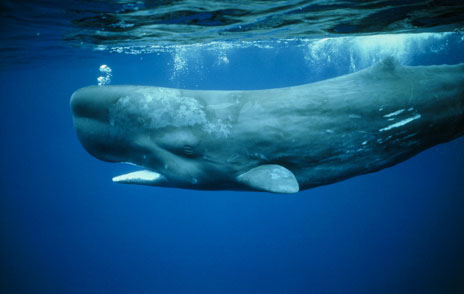Sperm Whale

Find A Hotel in Los Cabos
Fantastic deals on hotels in Los Cabos with our booking partners. Amazing discounts on over 100 properties, instant reservation and user reviews/ratings to guarantee you get the hotel you want, when you want it. In many cases you PAY NOTHING now...check it out here!
Sperm whales are characterized by their light grey color, white waxy film that covers their heads, a thick body that tapers at the tail and their lack of a dorsal fin. They are easily recognized by their massive heads and prominent rounded foreheads. They have the largest brain of any creature known to have lived on Earth. Their heads also hold large quantities of a substance called spermaceti. Whalers once believed that the oily fluid was sperm, but scientists have recently shown that it is used to help focus the sounds, "clicks", used in echolocation and hunting produced by whales as they dive. Sperm whales are known to dive as deep as 3,280 feet in search of food. These giant mammals must hold their breath for up to 90 minutes on such dives. Studies on their bone structure have shown that they suffer from decompression sickness ("The Bends") at times due to rising to the surface too quickly.
They can be found in all oceans and the Mediterranean Sea. Sperm whales have 20-26 teeth and feed primarily on squid, octopus, a diverse range of fish and, according to some reports, the mega-mouth shark. Adults eat one ton of food per day and it has been estimated that, at current population levels, Sperm whales consume more fish and squid than the entire world’s fishing fleets.
They are known to have epic battles with giant squid, often carrying battle-scars from squid suckers. They hunt by using their sonar and focusing beams of intense clicks which stun their prey. They are the loudest animal on the planet, emanating clicks at an astonishing 230 decibels. For a human, any sound above 85 Db can cause hearing loss and above 130Db will cause pain and discomfort: a 230Db sound is the equivalent of 32,000 tons of TNT going off or an earthquake of 5 on the Richter scale! A Sperm whale is therefore an underwater Death Star...
They are the most sexually dimorphic of the whales with the males being 30%-50% larger than females. Little is known about how the animals mate, but a female Sperm whale’s gestation period is about 12-14 months and they give birth about every 6 years. Calves can nurse for up to 13 years although a female Sperm whale is considered mature between 7-13 years old and a male is mature at 18.
Female Sperm whales travel with their young in groups of up to a dozen animals. Males tend to live in small groups or live as individuals. Young Sperm whales can face attacks by Orca and Pilot whales.
Sperm whales are often spotted in groups (called pods) of some 15 to 20 animals. Pods include females and their young, while males may roam solo or move from group to group. Females and calves remain in tropical or subtropical waters all year long, and apparently practice communal childcare. Males migrate to higher latitudes, alone or in groups, and head back towards the equator to breed. Driven by their tale fluke, approximately 16 feet (5 meters) from tip to tip, they can cruise the oceans at around 23 miles (37 kilometers) per hour.
Sperm whales were mainstays of whaling's 18th and 19th century heyday. A mythical albino Sperm whale was immortalized in Herman Melville's Moby Dick, though Ahab's nemesis was apparently based on a real animal whalers called Mocha Dick. The animals were targeted for oil and ambergris, a substance that forms around squid beaks in a whale's stomach. Ambergris was (and remains) a very valuable substance once used in perfumes.
Despite large population drops due to whaling, Sperm whales are still fairly numerous.
They can be seen in the Sea of Cortez all year round but tend to be in deeper water and are not common. When you find one however, you normally find a pod as they are social animals staying in groups of up to 15 individuals. At times, large quantities of Humboldt squid appear in the waters around Los Cabos and then is most likely the best time to look for Sperm whales as they follow one of their main prey species closer to shore.